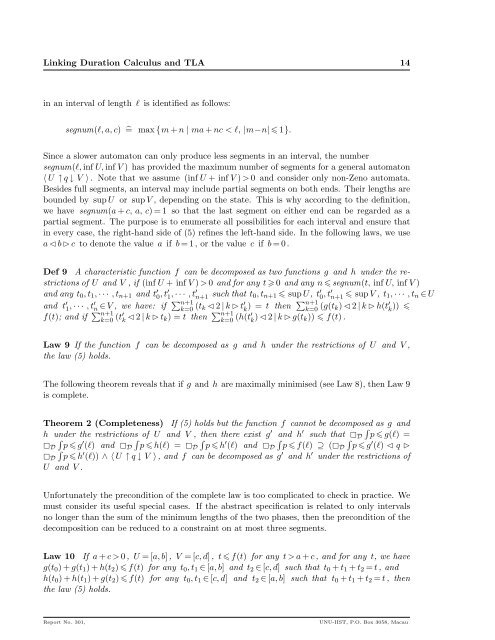IIST and UNU - UNU-IIST - United Nations University
IIST and UNU - UNU-IIST - United Nations University
IIST and UNU - UNU-IIST - United Nations University
You also want an ePaper? Increase the reach of your titles
YUMPU automatically turns print PDFs into web optimized ePapers that Google loves.
Linking Duration Calculus <strong>and</strong> TLA 14<br />
in an interval of length l is identified as follows:<br />
segnum(l, a, c) ̂= max {m + n | ma + nc < l, |m−n| 1}.<br />
Since a slower automaton can only produce less segments in an interval, the number<br />
segnum(l, inf U, inf V ) has provided the maximum number of segments for a general automaton<br />
〈 U ↑ q ↓ V 〉 . Note that we assume (inf U + inf V ) > 0 <strong>and</strong> consider only non-Zeno automata.<br />
Besides full segments, an interval may include partial segments on both ends. Their lengths are<br />
bounded by sup U or sup V , depending on the state. This is why according to the definition,<br />
we have segnum(a + c, a, c) = 1 so that the last segment on either end can be regarded as a<br />
partial segment. The purpose is to enumerate all possibilities for each interval <strong>and</strong> ensure that<br />
in every case, the right-h<strong>and</strong> side of (5) refines the left-h<strong>and</strong> side. In the following laws, we use<br />
a ⊳ b ⊲ c to denote the value a if b = 1 , or the value c if b = 0 .<br />
Def 9 A characteristic function f can be decomposed as two functions g <strong>and</strong> h under the restrictions<br />
of U <strong>and</strong> V , if (inf U + inf V ) > 0 <strong>and</strong> for any t 0 <strong>and</strong> any n segnum(t, inf U, inf V )<br />
<strong>and</strong> any t 0 , t 1 , · · · , t n+1 <strong>and</strong> t ′ 0 , t′ 1 , · · · , t′ n+1 such that t 0, t n+1 sup U, t ′ 0 , t′ n+1 sup V , t 1, · · · , t n ∈ U<br />
<strong>and</strong> t ′ 1 , · · · , t′ n ∈ V , we have: if ∑ n+1<br />
k=0 (t k ⊳ 2 | k ⊲ t ′ k ) = t then ∑ n+1<br />
k=0 (g(t k) ⊳ 2 | k ⊲ h(t ′ k )) <br />
f(t); <strong>and</strong> if ∑ n+1<br />
k=0 (t′ k ⊳ 2 | k ⊲ t k) = t then ∑ n+1<br />
k=0 (h(t′ k ) ⊳ 2 | k ⊲ g(t k)) f(t) .<br />
Law 9 If the function f can be decomposed as g <strong>and</strong> h under the restrictions of U <strong>and</strong> V ,<br />
the law (5) holds.<br />
The following theorem reveals that if g <strong>and</strong> h are maximally minimised (see Law 8), then Law 9<br />
is complete.<br />
Theorem 2 (Completeness) If (5) holds but the function f cannot be decomposed as g <strong>and</strong><br />
h under the restrictions of U <strong>and</strong> V , then there exist g ′ <strong>and</strong> h ′ ∫<br />
∫<br />
such that D p g(l) =<br />
D p g ′ ∫ ∫<br />
(l) <strong>and</strong> D p h(l) = D p h ′ ∫ ∫<br />
∫<br />
(l) <strong>and</strong> D p f(l) ⊇ (D p g ′ (l) ⊳ q ⊲<br />
D p h ′ (l)) ∧ 〈 U ↑ q ↓ V 〉 , <strong>and</strong> f can be decomposed as g ′ <strong>and</strong> h ′ under the restrictions of<br />
U <strong>and</strong> V .<br />
Unfortunately the precondition of the complete law is too complicated to check in practice. We<br />
must consider its useful special cases. If the abstract specification is related to only intervals<br />
no longer than the sum of the minimum lengths of the two phases, then the precondition of the<br />
decomposition can be reduced to a constraint on at most three segments.<br />
Law 10 If a + c > 0 , U = [a, b] , V = [c, d] , t f(t) for any t > a + c , <strong>and</strong> for any t, we have<br />
g(t 0 ) + g(t 1 ) + h(t 2 ) f(t) for any t 0 , t 1 ∈ [a, b] <strong>and</strong> t 2 ∈ [c, d] such that t 0 + t 1 + t 2 = t , <strong>and</strong><br />
h(t 0 ) + h(t 1 ) + g(t 2 ) f(t) for any t 0 , t 1 ∈ [c, d] <strong>and</strong> t 2 ∈ [a, b] such that t 0 + t 1 + t 2 = t , then<br />
the law (5) holds.<br />
Report No. 301,<br />
<strong>UNU</strong>-<strong>IIST</strong>, P.O. Box 3058, Macau
















